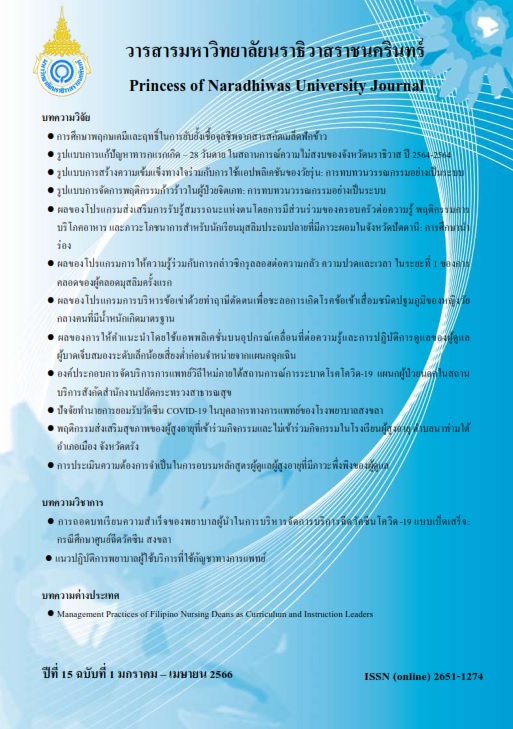Effectiveness of Discharge Instruction on Mobile Application toward Knowledge and Care Practice of Caregivers of Patients with Low Risk Mild Traumatic Brain Injury before Discharge from Emergency Department
Keywords:
Discharge instruction, Mobile application, Caregivers of patients with low risk mild traumatic brain injury, Emergency departmentAbstract
This quasi-experimental study aimed to determine the effectiveness of discharge instruction on mobile application toward knowledge and care practice of caregivers of patients with mild traumatic brain injury in low risk before discharge from emergency department in the lower-southern provinces. Purposive sampling was used to select 50 participants into the study. The participants were divided into two groups; 25 participants per group. The control group received usual nursing care, whereas the experimental group received discharge instruction through mobile application. The research instruments consisted of mobile application, a questionnaire asking about knowledge and a questionnaire asking about care practice which the the questionnaires received the reliability KR20 at .82 and .84, respectively. The data were analyzed using descriptive statistics, dependent t-test and independent t-test. The study results showed as follows: (1) The mean score of using mobile application in the experimental group was significantly higher than before using the mobile application (t= 13.52, p < .05) (2) The mean score of caregivers’ knowledge and care practice for patients with mild traumatic low risk brain injury in the experimental group was significantly higher than the control group (t = 19.90, p <. 05) and (3) The mean score of the 24-hour post-injury care practice in the experimental group using mobile application was significantly higher than the control group receving usual care (t = 15.13, p < .05). The results also showed that using mobile application enabled caregivers to provide better care for the patients. Therefore, it is suggested for nurses to use this application as a part of the patient care; recommend to caregivers to observe and track the patients’ conditions at home.
References
Armitage, L.C., Kassavou, A., & Sutton, S. (2020) Do mobile device apps designed to support medication adherence demonstrate efficacy? A systematic review of randomised controlled trials, with meta-analysis. British Medical Journal, 10, 1-9.
Benferdia, Y., & Zakaria, N., H. (2014). A systematic literature review of content-based mobile health Journal of Information Systems Research and Innovation.
Brame, C.J. (2015). Effective educational videos. Retrieved Principles and guidelines for maximizing student learning from video content. Life Sciences Education. 15(4). 46-55.
Chaisongmuang, P., & Pearkao, C. (2017). Effects of first aid to sudden cardiac arrest program for high-school students in northeast Thailand. Nursing Journal of the Ministry of Public, 118-132.
Chang, H. Y., Hou, Y. P., Yeh, F. H., & Lee, S. S. (2020). The impact of an mHealth app on knowledge, skills and anxiety about dressing changes: A randomized controlled trial. Journal of advanced nursing, 76(4), 1046–1056.
Dewan, M. C., Rattani, A., Gupta, S., Baticulon, R. E., Hung, Y. C., Punchak, M., … & Park, K. B. (2018). Estimating the global incidence of traumatic brain injury. Journal of neurosurgery, 1-18.
Gagne, R. M. (2005). Principles of instructional design. Wadsworth/Thomson Learning.
Gioia, G., & Collinsin, M. (2006). Acute concussion evaluation care plan. Retrieved from https://www.cdc.gov/headsup/pdfs/providers/ACE_care_plan_ school_version_a.pdf
Hoek, A.E., Anker, S., Van Beeck, E.F., Burdorf, A., Rood, P., & Haagsma, J., A. (2020). Patient discharge Instructions in the emergency department and their effects on comprehension and recall of discharge instructions: A systematic review and meta-analysis. Annals of Emergency Medicine, 75(3), 435–444.
Karinchai, K. (2011). Factors influencing applications downloading for iPhone (Master of Science Program in Innovation and Technology Management). College of Innovation, Thammasat University. Bangkok. (in Thai)
Phuenpathom, N., & Sikitwilaikul, T. (2019). Clinical practice guidelines for traumatic brain Injury. Retrieved from http://www.neurosurgerycmu.com/files/2019/12/GPG-final-2562-compre ssed.pdf
Polit, D.F., & Beck, C.T. (2012). Nursing research, principles and methods. (9th ed.) Philadelphia, Pa., Lippincott Williams & Wilkins. Nursing Practice. (8th Edition). Philadelphia, PA., Lippincott Williams & Wilkins
Samakit, N., & Wannasitorg, A. (2018). Relationships between headache, fatigue, sleep disturbance, and performance in mild head injury patients. Journal of Nursing and Health Care, 34(2), 152–163.
Sanguansin, R. (2018). Caring for head injury patients to specific disease certification (1st). Faculty of medicine Prince of Songkhla university (in thai)
Slater, B.A., Huang, Y., & Dalawari, P. (2017). The impact of teach-back method on retention of key domains of emergency department discharge instructions. The Journal of Emergency Medicine, 53(5), e59–e65.
Somsri, S., Sukonthasarn, A., & Wangsrikhun, S. (2016). Effects of emergency department discharge planning for persons with mild traumatic brain Injury on caregivers’ knowledge and practices. Nursing Journal, 44(1). 86-98.
Suffoletto, B., Akers, A., McGinnis, K.A., Calabria, J., Wiesenfeld, H.C., & Clark, D.B. (2013).
A sex risk reduction text-message program for young adult females discharged from the emergency department. Journal of Adolescent Health, 53(3), 387-393.
Thaweekhoon, R., & Pearkao, C. (2019). Effects of a smartphone application on knowledge discharge outcome among patients with mild traumatic brain injury. Journal of the Royal Thai Army Nurses, 20(2), 272-279.
Theadom, A., Parag, V., Dowell, T., McPherson, K., Starkey, N., Barker-Collo, S., … Feigin V., L. (2016). Persistent problems 1 year after mild traumatic brain injury, a longitudinal population study in New Zealand. The British Journal of General Practice, 66(642), e16-e23.
Utaisang, A., & Pearkao, C. (2016). Factors associated with severity level of post-concussion syndrome in patients with mild traumatic brain injury. Retrieved from https://gsbooks. gs.kku.ac.th/59/ingrc2016/pdf/MMO10.pdf.
Additional Files
Published
How to Cite
Issue
Section
License
Copyright (c) 2023 Princess of Naradhiwas University Journal

This work is licensed under a Creative Commons Attribution-NonCommercial-NoDerivatives 4.0 International License.




